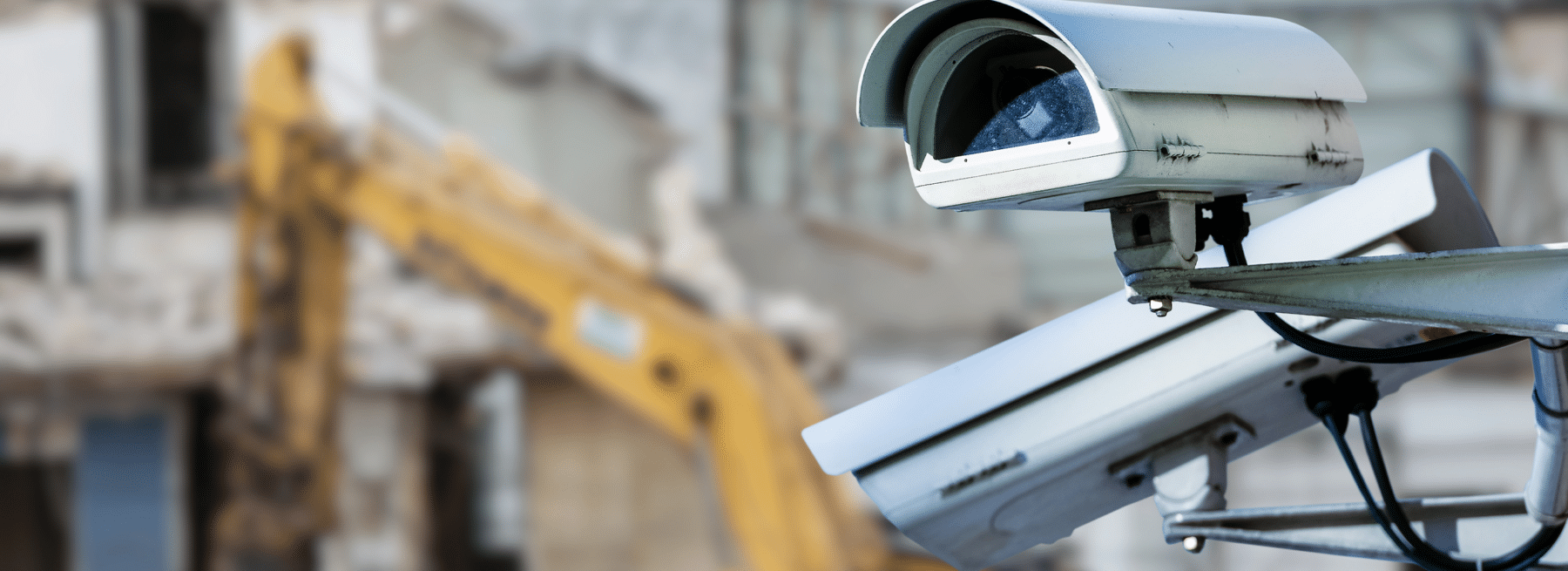Thanks to the price of materials reaching an all-time high along with inflation and the supply chain mess, construction theft continues to plague the industry. On top of this, equipment rental fraud and thefts have been rising since 2018 according to a Verisk National Equipment Register article. The trend persists this year.
Moreover, smash and grabs plague the construction industry. According to a Verisk infographic, 320 equipment theft incidents have been reported over the Memorial Day holiday weekend. And the report indicates one of the most targeted locations is construction sites.
Construction Theft Statistics
Almost every construction business knows about the National Equipment Register report that reveals theft of heavy equipment costs an average of $400 million dollars every year. What’s alarming is that the data doesn’t count for the cost of lost workdays due to the need to replace the stolen equipment. The report clearly states the data comes from reported thefts they know about. Many go unreported.
That’s not all for construction theft statistics.
- Propmodo says the most common cause of thefts on construction sites is due to “security negligence,” which means they don’t have sufficient construction site security and lighting.
- NER has also found fewer than one-quarter of stolen construction materials and equipment are ever recovered.
- In its 35 years of tracking data, the Associated General Contractors of America says the prices for construction materials have experienced the highest monthly and yearly increases. The situation is bad enough to compel AGC to issue a construction inflation alert.
- Some of the most common stolen items from construction sites are copper, other metals, lumber, heavy equipment, and tools. According to the Department of Energy, $1 billion dollars’ worth of copper is stolen every year.
- It’s no surprise that copper is sought after as CNBC reports copper prices have soared by more than 30% in 2021. Copper theft can halt a construction project.
- In Colorado, construction companies have lost $1.04 million from construction site thefts in 2021 according to KOAA News.
- CTV News says Canada has seen a rise in lumber thefts since 2018.
- Power tool theft is growing as the NYU Dispatch reports it will continue to skyrocket to at least 2025. The reason for the increase in thefts is that criminals believe law enforcement won’t waste their time with lower-priced items.
- A 2-by-4 that sold for $2.25 before the pandemic cost $5 or more after the pandemic per a Forbes story. And materials are not likely to return to pre-pandemic levels anytime soon.
The report from National Equipment Register says equipment theft patterns tend to mirror the overall economy. Despite North America seeing some progress toward normalcy, the demand for equipment continues to climb. The supply chain has caused a shortage of equipment. NER recommends construction sites to be on guard for theft.
This, in turn, has led to an increase in demand. You know with a decrease in supply and an increase in demand comes an increase in theft. Thus, it’s crucial to prevent theft from happening. It will be harder to find a replacement, whether it’s a rental, used equipment, or new equipment.
You may think this won’t happen to your construction site. Thinking this way will put your construction business at a bigger risk for huge losses if construction theft happens on your job site and you can’t replace the stolen equipment.
6 Ways to Prevent Construction Theft
No matter how big your property or perimeter is, here are six ways you can strengthen your site security. These work even if you have a lot of assets that cannot be locked up inside. The more of these you do, the more layers you’ll have in your construction site security. If thieves bypass a layer, the other barriers will slow their efforts. They may give up and find another site with fewer barriers.
1. Install a Fence around the Construction Site
Every construction site is different. You may or may not be able to put up a fence around the perimeter. If you can, set it up so that you have a single-entry point. This will lower the risk of trespassing on your construction site. Besides that, when you have only one entry point, it will give you more control over who comes and goes to the construction site including deliveries and pick-ups.
Even though intruders can cut the fence or climb it, you could add another obstacle by using barbed wires. The harder you make it for people to get on the construction site, the more likely they will leave yours alone and look elsewhere for an easier entry.
2. Add Proper Lighting
As the Propmodo article explains, dimly lit construction sites tend to attract criminals. One of the easiest, least expensive, and most effective options for security is lighting. Lights act as a deterrent when no one is on the property. Lighting also makes it challenging for intruders to hide while they vandalize or steal, so they tend to find another property or business to raid.
The right kind of lighting matters. There’s more to lighting than brightness. Color and hue can impact its effectiveness. Consider meeting with a security expert who can evaluate your construction site and make lighting recommendations. It will also help you avoid overspending or underspending on lights. There are a lot of factors to review when it comes to effective lighting.
3. Lock up Expensive Equipment and Materials
Obviously, it’s not always possible to lock up equipment as some items are too large. However, organized crime gangs will steal heavy equipment. They’ll bring a trailer and load it up. For equipment you can’t lock up, add a GPS tracker. This brings up the next item.
4. Inscribe Identifiable Information on Equipment
Engrave or stamp identifiable information on your most important, expensive assets. It may seem daunting to do an inventory of all your assets. Start small with the most business-critical and expensive assets. You may want to add covert GPS trackers to these.
When you incorporate an asset management system (next item), GPS trackers can help you know where all your assets are located at all times. Any time equipment breaks, then you open the asset management tracking system to search for a replacement somewhere in the business.
GPS trackers are not perfect. Organized crime gangs and seasoned thieves may use GPS jammers to prevent the GPS from working. That’s why it’s important to etch identifying information on the tools and equipment. An asset management tracking system can do more than provide you with details about your assets after a theft.
5. Use an Asset Management System
If you’re in the same boat as the rest of the construction industry, you’re most likely dealing with a shortage of skilled workers. Therefore, it’s critical to have them spend time on the most important tasks and less on manual tasks. Construction managers spend too much time searching for equipment, inventory, and other assets.
Additionally, assets need to be serviced and maintained like personal vehicles. An asset tracking system will simplify and automate the process of knowing what needs repairing or servicing. Keeping equipment well-maintained will reduce the chances of heavy equipment not working. In doing so, you avoid losing hours of productivity in locating and transporting a replacement.
You may have a replacement. However, it will take time to ship it to the construction site. Because of this, you may end up renting equipment or postponing the construction until it arrives. Both come at a cost. An asset management system can prevent this from happening.
It will help with ensuring the jobsite has the right asset at the right time. Since the system notifies you when the equipment needs servicing and you follow through, then they will most likely work as expected and last longer.
A construction site must make the most of every asset and worker especially with the workforce shortage and the exorbitant cost of materials. An asset management system will cut the risk of broken equipment, injuries, and lost billable time that comes from sending broken assets to a jobsite.
6. Invest in Remote Video Surveillance
An effective construction site security system needs to be proactive in order to help deter theft. A powerful, proactive security system with built-in security layers is video surveillance security with remote monitoring and video analytics. This security technology provides your jobsite with two sets of eyes thanks to the trained monitoring operators and video analytics.
Analytics helps reduce the operator’s workload. You gain the best of both worlds by combining humans with technology. This allows them to help catch potential problems before anything happens.
These trained monitoring operators do not work on the jobsite. Working with video analytics, the operators can help spot intruders approaching the construction site and take action. They can issue a warning on an on-site speaker system. If this doesn’t stop the suspects, the operator can contact law enforcement while tracking the intruders’ movements.
The advantage remote video surveillance has over traditional security systems is that your construction site can have eyes on it in multiple areas at the same time. Moreover, the visibility of the cameras alone can deter some criminals especially when you post signs indicating the area is under surveillance.
That’s because more than 80 percent of crooks look for visible security like an alarm or video surveillance before breaking in according to a study from UNC Charlotte. Therefore, remote video surveillance can be one of the most effective crime deterrents. Additionally, it can deliver a fast ROI.
Construction sites have a responsibility for visitor, vendor, and worker safety. The price of not having an effective security solution can potentially put an innocent person’s life at risk as criminals are growing more violent and dangerous. Video surveillance can offer the highest level of security for your jobsite. Many ECAM clients achieve an ROI within four months.
To learn more about security to help prevent construction theft, download the construction security and safety best practices guide. This guide discusses industry challenges and solutions. If you’d like to know more, feel free to contact us.

